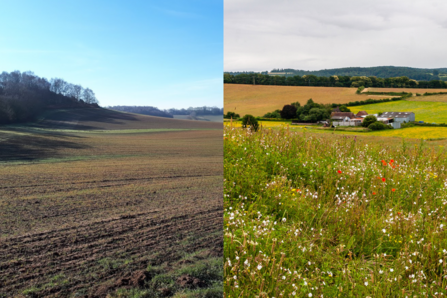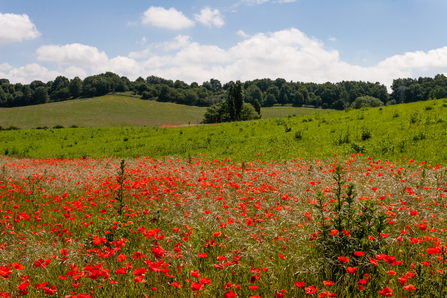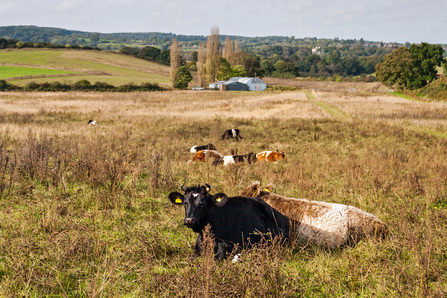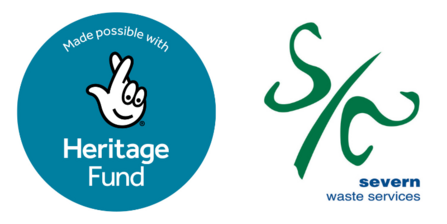Well, I can’t believe it - we are halfway through the Saving Worcestershire’s Heathlands project! Now we've reached this milestone, it’s about time that we look back on all that we’ve achieved since we acquired Dropping Well Farm in 2021. What better way to reflect on our progress than by comparing the photos below that show the transformation from arable land in 2018 to the beautiful grassland of July last year.
Saving Worcestershire's heathlands - we're now halfway!
View over Dropping Well Farm, The Devil's Spittleful and Rifle Range nature reserves by Wendy Carter

Dropping Well Farm by Wendy Carter and Paul Lane
Andy, our northern reserves officer, has installed 4km of fencing on site, creating protected compartments where wildlife can return and thrive whilst still maintaining public access along the railway line. Across Dropping Well Farm we have sown areas with a flower-rich mix of grasses and wildflowers that include clover, bird’s-foot trefoil, knapweed, sheep parsley, salad burnet, ribwort plantain and yarrow. These provide food and shelter for lots of invertebrates, such as bees, beetles and earthworms, as well as improving soil structure and water infiltration. The vegetation gives cover to small mammals and these in turn attract predators like kestrels, peregrines, sparrowhawks and buzzards looking for food. Other birds, such as skylarks, nest in the long meadow.

Poppies at Dropping Well Farm by Paul Lane
Some annual plants only grow in disturbed patches of land, so we continue to cultivate some areas to allow annual wildflowers like poppies to flourish. In other areas we are doing nothing and letting nature take its course, allowing local species to self-seed and colonise these areas.
Whilst we have made lots of quick changes to support wildlife on the nature reserve, heathland restoration is a long process. Dropping Well Farm has been cultivated and fertilised to grow crops, so bringing it back to nutrient-poor, acidic sandy soil that’s typical of heathland isn’t a quick job. Our trusty cows do a great job of grazing the meadows, which removes some nutrients from the soil and creates spots of bare soil for bees to nest in and for lizards to bask in the summer sun. If you have been there recently you will know how magical it is to see the meadow blowing in the breeze and the cows sauntering around in the sunshine - it’s hard to imagine that only a few years ago these fields were filled with a single crop!

Cows at Dropping Well Farm by Paul Lane
Bee bank at Dropping Well Farm by Shauna McLaren
Although Andy and the cows do a phenomenal job, we wouldn’t be where we are today without the amazing support we have from you, the volunteers and the local community. The purchase would not have been possible without the £1 million raised from 1,000 donations, ranging from £1 to £50,000, that we received from members and supporters. We also received countless messages of support from people willing us on, which all happened in the autumn of 2020 when the country was battling COVID-19.
We must also thank and recognise the incredible work of the Esmee Fairbairn Foundation that purchased the land and gave us the time to raise the funds to buy it. We're also grateful to The National Lottery Heritage Fund, who have funded the Savings Worcestershire’s Heathlands project and are the reason we can engage with local communities on and off the nature reserve. With this funding, we have been able to work with 500 new people on the reserve, including schools/colleges and local youth groups. In local communities, we have worked with over 1,000 people, sharing the story of our heathland and encouraging individuals to take action for nature. It’s been heart-warming to see the love for the heathland amongst locals. With so many people learning about heathland, we hope that more people will be able to enjoy the nature reserve whilst protecting the nature that lives there.
Finally, the heathlands would not be where they are today without people donating their free time to help us restore these rare habitats. With the help of our volunteers, we have created more open spaces where heathland fauna and flora can thrive and introduced habitats, such as hibernacula and bee banks, to encourage heathland species back to the farmland.
We've got two and half more years to go and are really looking forward to engaging even more people with this wonderful heathland, whether they're in and around the communities on our doorstep and both on and off the nature reserve.
On to the next half of the project!


